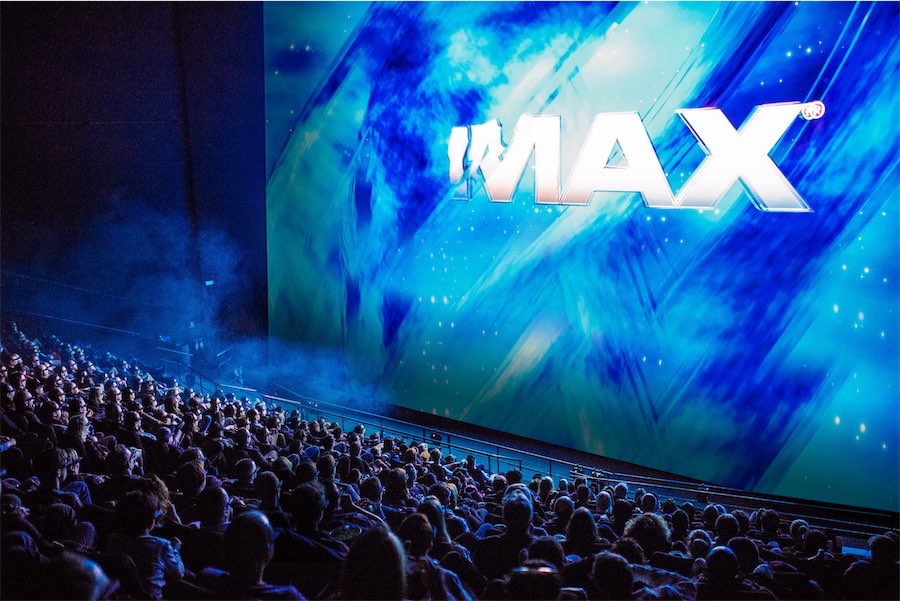
Canberra is about to get only the third IMAX cinema screen in Australia when Dendy sparks up the state-of-the-art laser projector on to a giant screen in a refurbished cinema in November. But what is IMAX and where did it come from? Pass the popcorn, cinema tragic SIMON COBCROFT has the answers.
If you think you’ve seen a film on the big screen in Canberra, think again, because cinema is about to get a lot bigger. Up to three times bigger, in fact.
Yes, Canberra will soon join Sydney and Melbourne in being one of the only places in Australia to experience the world’s largest cinema screen – IMAX.
Opening in November, the new Dendy IMAX will cover the entire wall of Dendy’s currently biggest cinema in Civic. In a dramatic refurbishment, the cinema’s old 2K projector will be replaced by a state-of-the-art laser projector, which can show films in stunning 4K resolution.
In addition, the old seats will be ousted in favour of plush chairs, recliners, and even sofas, that will seat a total of 300 people.
As for sound, a new 12-speaker surround system will be installed, which will accompany a 1:9 aspect ratio screen (up from 1:85:1) and, unlike some IMAXs, the Dendy IMAX will be able to show 3D movies. So, James Cameron will be happy.
But what does all that guff mean to folks who don’t drool over such movie mumbo-jumbo?
Well, details will be finer and sharper. Colours will “pop” with vibrancy. Motion on screen will be more fluid and soundtracks will stir you with new-found delight. Or, putting it another way, it’s like Canberra only had a McDonalds and a Michelin restaurant was about to open. For film-feasters, it’s salivating stuff.
And before you start thinking we’ve been plied with a Kool-aid slushie from some Dendy PR flack, the hype is true. IMAX has for a long time been the way most film directors want people to see their movies. It is the reference point for what a cinema experience should be. And with Dendy managing Canberra’s IMAX, it won’t just be the latest Marvel film that Canberrans will get to see, shown at its best.
What is IMAX?
The original idea behind IMAX can be traced back to the 1920s when cinema was, arguably, in its heyday.
Before radio, TV, streaming, and whatever the kids were into last Wednesday, cinema was the world’s most popular form of entertainment. At its height in the mid-20s, more than 90 million people were going to see films every week.
All of which was facilitated by cinema moguls, with big dreams and even bigger pockets. Such as the Hungarian Jew, William Fox, who had gone from being a two-bit candy salesman to a millionaire confectioner of a different sort with the establishment of his Fox Film Studios.
But while the 35mm silent films of the time were big, Fox envisioned them becoming even bigger with his new 70mm Fox Grandeur format. And what’s more, he planned to launch it with a $2 million extravaganza, The Big Trail, a Western starring John Wayne in his first lead role. Fox was going to show the world how great cinema could truly be!
Well, that was the plan. Apart from having to recoup a budget that was almost 200 times that of a standard film, Fox’s main problem was finding cinemas that could show his massive new film format. In the end, only two cinemas screened The Big Trail, and even then, that was only with the help of Fox’s money, to install the necessary Grandeur projectors and screens. But Fox’s woes didn’t stop just there. He was also facing a major antitrust investigation from the US Justice Department and, when out for a pleasant drive, crashed his car and sustained serious injuries that left him crippled for life.
Then, in 1929, the stock market crashed. Fox lost everything. But rather than face bankruptcy, Fox took up a long-standing offer from 20th Century Pictures. The resultant merger of the two studios would, of course, become the century’s biggest box-office behemoth, 20th Century Fox.
After Fox’s follies, cinema wouldn’t try large-screen formats again until the 1950s, when the threat of TV forced them to go bigger or have their audiences stay home.
Formats such as Cinerama and CinemaScope were invented, but these all used existing 35mm projectors (with anamorphic lens to make them wider). But again, like in the 1920s, many cinemas refused to spend money to upgrade to the bigger screens needed to show them.
Then, for a brief time, showbiz impresario, Mike Todd, tried to revive Fox’s 70mm Grandeur format with his Todd-AO format.
The only problem was that Todd’s new colour format, with its six magnetic soundtracks, was 5mm thick (normal 35mm film is 0.025mm) and was a beast to run. Projectionists would complain that, when Todd-AO projectors weren’t screaming like banshees under the weight of the film, they were seizing up and burning the film. And nobody much liked to see David Niven and Shirley MacLaine merge into a fiery mess in the closing scene of Around The World in 80 Days. So, the format was once again abandoned.
It wasn’t until Expo 67, in Montreal, that a workable version of Fox’s vision at last came into focus. The National Film Board of Canada had workshopped the idea of wowing Expo goers by showing them the “cinema of the future”. They called it Multiscreen and it was to be a Heath Robinson affair involving the analogue synchronisation of 24 35mm projectors showing parts of a single film on a screen the size of a three storey-building. Now to get someone to build the goldarn thing. After enduring hell to get the thing to work even occasionally, the contractors on the project (otherwise known as the poor saps) thought, there’s got to be a better way. And possibly, is this Canadian “cinema of the future” good for the mental health of future projectionists?
Enter the affable Ron Jones from Brisbane
Enter the affable Ron Jones from Brisbane. Aussie Ron wasn’t much interested in cinema. He was dealing with a different problem.
Jim Hood, a doctor working for the National Heart Foundation of Australia had approached Ron in 1965, as he knew Ron had a reputation for being something of a crack engineer.
Hood wanted to know if there was any way that Ron could improve the radiography equipment he was using in hospitals? Making X-ray movies of maladies back in the 1960s was fraught with problems. Radiography machines had to move custom rolls of thick film, some as big as 43cm squared, across a camera that was inches away from a patient, at consistent speeds, without shuddering or seizing or worse.
Sound familiar? It was the same problem that Mike Todd’s cameras and projectors had faced a decade earlier.
So, Ron came up with a genius solution – the rolling loop. Instead of the film going through sprockets like a traditional camera or projector, it would go through rollers that would smoothly guide the film over an elevated lens rather than ratchet it forward, one frame at a time. Not only was it an elegant solution, it also allowed different lenses to be inserted into the camera for different shots. Hood loved it and before long, Ron’s rolling loop was rolling out to radiography wards across Australia.
Which is how the word got out to those Canadians pulling out their hair back at the 67 Montreal Expo. They had seen one of Ron’s radiography machines and had thought it to be a complete waste to medicine.
What it really was, if anyone was to properly look at it, was the answer to Canada’s “cinema of the future”. Yes, Ron’s brilliant bit of baffle could finally solve the age-old problem of smoothly projecting large-format film.
And with the ability to up the lens on the thing, size was no longer an issue either. Bring on a 10-storey building, even! The Canadians immediately hopped on a plane to Brisbane, met Ron, and bought the rights to his technology on the spot. Their hair thanked them.
With a basis for projecting heavy 70mm film without issue, the Canadians were off. After the stress of the 67 Expo was over, a group of them got together to talk about future projects.
Was it the ghost of Hungarian William Fox that drew them to a Hungarian restaurant in Montreal? Was it his spectral hand that guided them to scrawl ideas on a bit of paper on how they might commercialise Ron Jones’ rolling loop technology? “Maximum Image” was their concept; very much in line with Fox’s Grandeur aspirations. This was then shortened to “Max-I,” then reversed to I-MAX. And thus, the IMAX Corporation was formed.
IMAX opened its first cinema in Toronto in 1971 and by the end of the decade would have 18 theatres around the world. The problems it initially faced were not dissimilar to the ones Fox faced back in the 1920s. IMAX cameras and projectors were expensive and the cost of 70mm film meant that the films shown needed to be short to make their money back.
Early IMAX films were often gimmicky
The early IMAX films were often gimmicky “experiences” taking audiences from flying on a hang glider over the Rockies to being surrounded by sharks in the Great Barrier Reef.
It wouldn’t be until 1999, when IMAX had 148 theatres around the world, that the first feature-length film would be shown in an IMAX cinema. The film was Disney’s Fantasia 2000, the musical sequel to Disney’s original 1940 film, which had itself pioneered one of the first surround sound formats, Fantasound.
In 2008, the digital IMAX format was introduced, and many IMAX cinemas replaced Ron Jones’ rolling loop projectors with cheaper digital projectors. The results weren’t great. The new 2K digital format (similar to the 1080p of your standard TV), while cutting-edge at the time, had noticeably less resolution than 70mm film and the format soon became disparagingly known as LieMAX. Many IMAX cinemas refused to convert to the new format until the quality improved.
Which it did in 2012 with the introduction of 4K laser projection. IMAX technology was, at last, reliably good and reasonably priced. William Fox could finally stop turning in his grave.
The new 4K projectors saw a global boom in IMAX cinemas that continues to this day. There are currently 1700 IMAX cinemas flickering faces around the globe as I write this. Their allure is the same the world over – seeing films in a way that no home experience can ever replicate.
And now little old Canberra has one, too. Let’s hope Dendy gets our IMAX right and that Canberrans see the light on what all the fuss is about. Of course, if Canberrans get a taste for how good a film can look on the IMAX, it might prompt the other cinemas in town to start talking to their banks about upping their game. Did someone say 8K?
Who can be trusted?
In a world of spin and confusion, there’s never been a more important time to support independent journalism in Canberra.
If you trust our work online and want to enforce the power of independent voices, I invite you to make a small contribution.
Every dollar of support is invested back into our journalism to help keep citynews.com.au strong and free.
Thank you,
Ian Meikle, editor





Leave a Reply